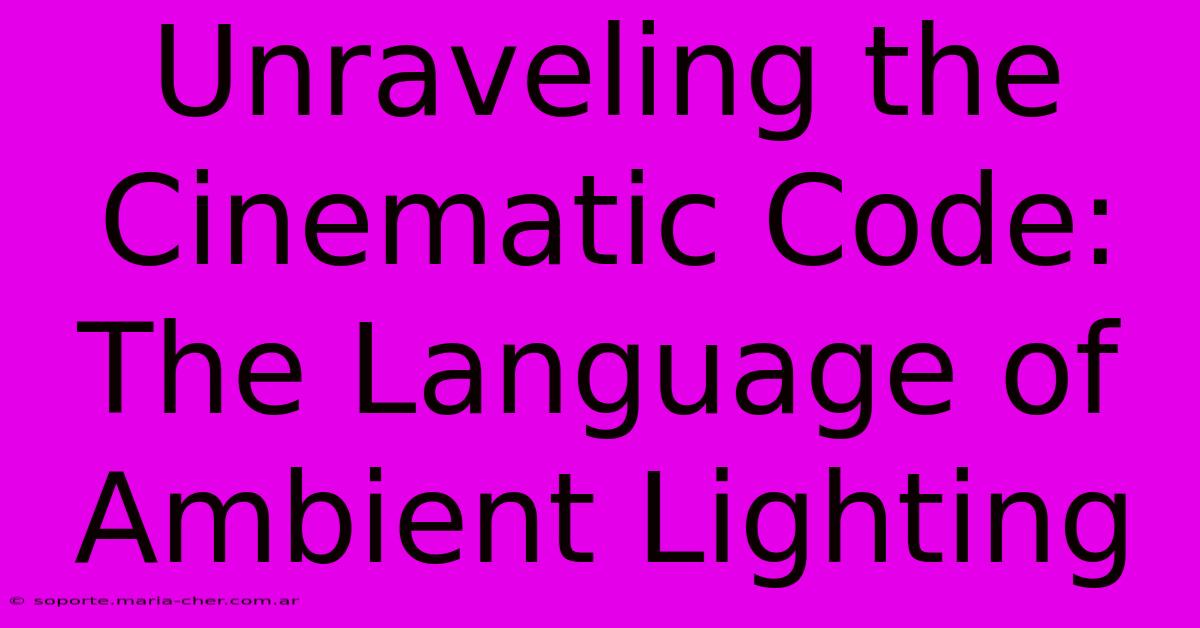Unraveling The Cinematic Code: The Language Of Ambient Lighting

Table of Contents
Unraveling the Cinematic Code: The Language of Ambient Lighting
Ambient lighting. It's a term often whispered in hushed tones among cinematographers, a crucial element that often goes unnoticed by the casual viewer, yet profoundly shapes the mood, atmosphere, and overall storytelling of a film. This isn't just about brightness; it's a powerful tool that dictates emotion, reveals character, and sets the stage for dramatic tension. This article will delve into the subtle yet significant role of ambient lighting in filmmaking, exploring its techniques and impact.
What is Ambient Lighting?
Ambient lighting, simply put, refers to the general, overall illumination of a scene. It's the light that's already present in the environment – the soft glow of a twilight sky, the dim light of a moonlit night, the pervasive brightness of a sunny day. Unlike key lighting, which highlights specific subjects, ambient light provides a foundational layer, influencing the colors, shadows, and overall tone of the image. Think of it as the canvas upon which the rest of the lighting design is painted.
The Power of Subtlety
The beauty of ambient lighting lies in its subtlety. It's often less about bright, glaring illumination and more about establishing a mood and setting the scene. A dimly lit alleyway, for example, immediately evokes a sense of mystery and potential danger, while the warm glow of a fireplace creates a feeling of comfort and intimacy. The skillful use of ambient light can create a powerful emotional response without drawing attention to itself.
Techniques for Mastering Ambient Lighting
Cinematographers employ various techniques to manipulate and enhance ambient lighting:
1. Natural Light: Harnessing the Power of the Sun
Natural light remains the most powerful and versatile form of ambient lighting. The time of day, weather conditions, and even the angle of the sun all contribute to the overall mood and atmosphere. Shooting at "golden hour" (the hour after sunrise and before sunset) provides a warm, soft light, ideal for romantic or nostalgic scenes. Conversely, harsh midday sun can create strong contrasts and shadows, lending itself to more dramatic or intense sequences.
2. Practical Lighting: Incorporating Existing Light Sources
Practical lights are those that are already present within the scene itself—lamps, streetlights, neon signs, candles. These lights provide a sense of realism and contribute to the overall atmosphere. By strategically placing the camera to capture these practical lights, cinematographers can build a believable and engaging environment.
3. Artificial Ambient Light: Creating Mood and Atmosphere
Sometimes, natural or practical lighting might not be enough to achieve the desired effect. In such cases, artificial ambient lighting is used to supplement or enhance the existing light. This could involve using large soft sources to create a diffused, even illumination or strategically placed colored gels to alter the color temperature and mood of the scene.
The Impact of Ambient Lighting on Storytelling
Ambient lighting plays a crucial role in shaping the narrative and enhancing the emotional impact of a film. It can:
- Set the Tone: Dark ambient lighting often signifies suspense, mystery, or danger, while bright lighting can evoke feelings of happiness, hope, or optimism.
- Reveal Character: The way a character interacts with the ambient light can reveal aspects of their personality. A character shrouded in shadow might be hiding something, while one bathed in bright light might be open and approachable.
- Enhance Visual Storytelling: By carefully controlling the ambient lighting, cinematographers can guide the viewer's eye and focus their attention on specific elements of the scene.
Conclusion: The Unsung Hero of Cinematography
Ambient lighting is an often overlooked, yet essential element in cinematic storytelling. Its subtle influence profoundly impacts the mood, atmosphere, and emotional resonance of a film. By understanding its techniques and applications, filmmakers can unlock its powerful potential and elevate their visual narratives to new heights. Mastering ambient lighting is a crucial step towards becoming a truly skilled cinematographer. It's a journey of understanding light as a language, capable of conveying complex emotions and narratives with quiet power.

Thank you for visiting our website wich cover about Unraveling The Cinematic Code: The Language Of Ambient Lighting. We hope the information provided has been useful to you. Feel free to contact us if you have any questions or need further assistance. See you next time and dont miss to bookmark.
Featured Posts
-
Fantasy Impact La Vine And Fox Traded
Feb 03, 2025
-
Shakiras Inaugural Grammy Dance
Feb 03, 2025
-
Doechii Performs Catfish At Grammys
Feb 03, 2025
-
Unlock The Vibrant Spectrum Of Gel Nail Polish Dnds Collection Of Enchanting Hues
Feb 03, 2025
-
Unveil The Forgotten Luxury The Secrets Of Vermeil From Ancient Times
Feb 03, 2025
